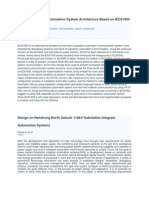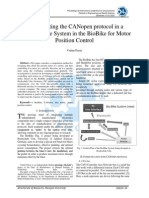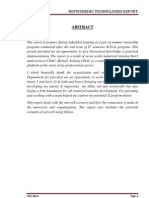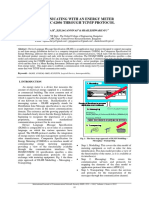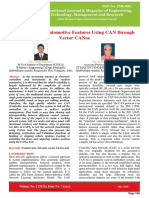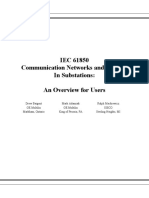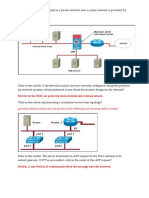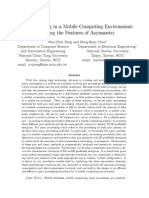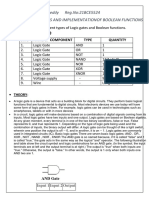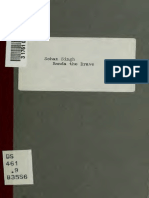Journal 1
Journal 1
Uploaded by
Dee MatOriginal Description:
Copyright
Available Formats
Share this document
Did you find this document useful?
Is this content inappropriate?
Report this DocumentCopyright:
Available Formats
Journal 1
Journal 1
Uploaded by
Dee MatCopyright:
Available Formats
Study of Applying CORBA-Based Distributed Object Technology to Next Generation of Power Dispatching Automation System
Huang Haifeng, Yang Zhihong and Zhang Shenming platforms , databases, communication protocols, and application program interfaces are not same. Since a unified standard is absent, all vendors describe the power system model with their private data structures, interfaces and communication protocols. These bring the communication difficulty and form the isolated island phenomena. So realizing the information share is the developing emphasis of the power dispatching automation [ 1],[4],[5]. Standard IEC 61970 is to build Common Information Model (CIM) to describe the power system object and to construct Component Interface Specification (CIS) to realize the interoperability of the system.
11. ADVANTAGE OF CORBA-BASED DISTRIBUTEDOBJECT
TECHNOLOGY
Abstract-The distributed object technology and its application in the next generation of a power dispatching automation system are introduced. Standard IEC 61970 is to found Common Information Model (CIM) for the power system objects and to form Component Interface specifications (CIS) for logical information exchanges among all applications. Standard IEC 61970 is the theoretical base of data models and distributed object technology is the technology guarantee of implementing this system. Each application, each service or each sub-system can be described as one or more components. All components are interconnected by an integration framework, which is composed of Object Request Broker (ORB) bus, namely the core of Common Object Request Broker Architecture (CORBA). In this paper, the background of developing a next generation of a power dispatching automation system complying with Standard IEC 61970 is reviewed. On tbe basis of a lot of testing data about CORBA performance, the feasibility of adopting CORBA-based distributed object technology is discussed. Constructing integration framework of the system and encapsulating the existing applications or programs are two. main methods about CORBA applications. Lastly, the whole system structure and its design scheme of the dispatching automation system are presented and analyzed.
Inder Terms-Energy Management System; CORBA; Power System; CIM; CIS; Component
I. INTRODUCTION
HE aim of setting up a power dispatching automation system is to ensure the security and stability of the power network operation. In order to transmit the power energy with high quality, and reduce the energy loss, multi-subsystems need to be operated in the same time, such as: Energy Management System (EMS), Tele-Meter Reading (TMR), and Distribution Management System (DMS). And each sub-system includes several applications, for example, SCADA, AGC, NA and DTS belong to EMS subsystem. Because in the control center, each sub-system or application may be developed by different vendors, and its software
Huang Haifeng works in Nanjing Automation Research Institute (NARI), Nanjing, P.R. China. (e-mail: huanghf200O@yeah,net). Yang Zhihong works in Nanjing Automation Research Institute (NARI), Nanjing, P.R. China (e-mail: young@nari-china.com) B a n g Shenming works in Nanjing Automation Research Institute (NARI), Nanjing, P.R. China (e-mail: zsm7005@nari-china.com).
Standard IEC 61970 is the theoretical base of data models in the next power dispatching automation system and distributed object technology is the technology guarantee of implementing this system. TCP/IP protocol is used in a local network communication normally. Although it has high efficient, this method depends on the network types, realizing language, application manner and system platform deeply. On the contrary, in the distributed object technology, TCP/IP protocol is shielded. The communication process is taken charge by ORBs. The development process centralizes on the mutual exchange data among component applications. After adopting ORBS, as long as the standard interface is followed, the connection of a server and a client object can be established by ORBs. The functions of ORB are as following: Receiving a service request sent by a client, and fulfilling the mapping of request in the server; Setting a route scheme and searching for a service object; Submitting client parameters; Returning to a client with a computing result of a service object. Fig. 1 is the progress of a client s ervice request. A client object sends a request to the implement of a service object. In fact, a client is an entity of sending a function request to a service object, and a service object includes data resource and realizing codes of this function. The function of an object request broker is to locate the service request, and to receive the service request of a client and to return an executing result to the client. After sending a request, a client object can get
0-7803-7459-2/02/$17.00 2002 IEEE 0
-621 -
the computing result of a service object by a polling or other manners.
I
OR
Fig 1 Client Service Request Progress
1 1 CORBA APPLICATION METHODS AND PROBLEMS IN THE 1.
POWER SYSTEM
Because the efficiency of the network communication using CORBA is lower than that using TCP/IP directly. At one time, it is doubtful whether CORBA can meet the real-time performance demand of the power system. The main problems show in two aspects: 0 Possibility of CORBA adopted in the power dispatching automation system; 0 Methods of CORBA applied in the power dispatching automation system. To the first problem, the answer is affirmative. Firstly, Standard IEC 61970 is the start and standpoint of the next generation of the system. CIM interface definition will become the formal standard. And the interface of each application must accord with component interface specifications, namely, each component shall encapsulate its relative application program codes, and offer a standard, public method to be visited by the other vendors. This can meet the demand of an open system interconnection. CORBA is the most suitable tool for constructing a component model. Secondly, CORBA is able to provide the simple, extensive and standardized integrated method and a system structure to solve the integration and development in a distributed heterogeneous environment. So CORBA ought to be adopted in the power system. To the second problem, there are two manners about CORBA application. 0 On the basis of meeting the real-time performance, CORBA can be used in constructing a system platform; 0 CORBA can be used to encapsulate the existing applications or services to form components The existing CORBA application status in the non-real-time system shows that CORBA can reduce the complexity of the distributed system. But CORBA applied in the control center should meet the real-time performance demand, especially for a real-time task, such as: alert, telemetry message transmit. So, CORBA performance test should be taken under a real-time condition.
IV. CORBA PERFORMANCE TEST
are synchronous invocation, oneway operation and deferred synchronous invocation. Because a deferred synchronous invocation manner is usually used in Dynamic Invocation Interface (DII), it is seldom used. [3] Besides in some scenarios, a more decoupled communication model between objects is required. For example, in the power dispatching automation system, if a measurement value exceeds the measurement limit value, and a alert message is sent by the monitoring program, and then the relative equipment can adjust operating status. If the monitoring program communicates with all relative members to inform the alert event information, this close-couple communication manner is very complex and influence on the systems scalable capability and the quantity variety of alert relative users. A decouple relation applied in alert event and alert object can simplify the communication process. [2] The Event service decouples the communication between objects. The Event service defines two roles for objects: the supplier role and the consumer role. Suppliers produce event data, and consumers process event data. Event data are communicated between suppliers and consumers by issuing standard CORBA requests. The Event service allows object log on and exit with a dynamic manner. Because the Event service offers a method for decoupled communication, the performance of the push model in suppliers and consumers is tested.
A. Testing Environment The test is operated in a lOOM local area network. There are one workstation (ULTRA 60 workstation, 667MHz CPU, 512M memory) and one server (SUN Enterprise 250,450MHz CPU, 128M memory). To avoid the disturbance and enhance the accuracy of the testing result, the following testing message format is adopted as shown in fig.2. Each item message has 540 bytes, and each group need send 30-item messages. In every test time, 10-group messages are sent. The actual testing time is the sum of sending 300-item messages, i.e. there are about 300-time invocations between a client and a server object.
B. Peflormance Analysis
First item Second item
......
thirtieth item
first group
......
tenth group
......
bytes bytes
*****.
......
Fig.2 Message Format in each testing time
On the basis of normal CORBA communication methods and combined with application features of a power system, CORBA communication performance is tested We know that the normal CORBA communication manners
Testing results is shown in fig.3. 50-time tests are carried out. Each testing cost time is shown in the Y-coordinate of fig.3. Fig.3a shows testing result in a synchronous invocation manner. In a synchronous invocation, before sending a next message; the client ,must wait for a current answer from a server, after a server disposes this invocation. So the cost time
- 622 -
is longer than that in an oneway operation manner. But the availability is very high. Fig.3b shows oneway operation testing result. Because of no answer from a server, the speed is very high. But compared with a synchronous invocation, the availability is relatively low. In an Event service, there are two basic models for . communicating event data between suppliers and consumers: the push model and the pull model. In the push model, a supplier pushes event data to a consumer. Compared with the push model, the way of acquiring data in a pull model is decided by the action sponsors. For example, obtaining data time is determined by the pull consumers. Because the pull action is active, only a push model is tested. Before messages sending by a supplier arrive at consumers, the messages must be transmitted in an event channel. The speed of the Event Service is low. But this is an asynchronous method. Fig.3~ is the testing performance of the push Event service.
1.6
h
a 1.4
C
gi ' i
E ss
9: 1.2
1.0
0.8
10
20
30
'
40
50
number of sending times (c)
Fig 3 Testing performance of CORBA common communication
0.21
'
10
'
'
20
'
.
a
30
'
'
40
'
'
50
Although the efficiency of CORBA is lower than that of other communications software that is constructed on TCP/IP protocol directly. But this technology improves system opening and reliability greatly. Known from the CORBh performance test, if the component granularities are not very small, the system CORBA platform can meet the communication demand among components of the power dispatching automation system, such as alert service, report form service, and SCADA, PAS, DTS application. But to high real-time communication tasks, for instance, the communication among front machines and SCADA data servers should consider to make on TCP/IP protocol.
number of sending times
v. APPLICATION OF CORBA IN POWER DISPATCHING
AUTOMATION SYSTEM
To sum up, the structure of the power dispatching
0.001
"
10
20
'
"
30
40
'
'
50
number of sending times b
7
Database Management System
Fig. 4 Structure ofNext Power Dispatching Automation System
automation system is shown as fig.4. CORBA technology can be used in shallow parts of fig.4. In the bottom part, CORBA is used to integrate a heterogeneous system, and the main task is to sustain internal several communications protocols and to solve high performance communication in a heterogeneous environment. In this part, CORBA need have a real-time
- 623 -
performance. The database management system part answers for exchanging data models and data formats in the real-time database with orient-object, relational and hierarchy characteristics. In the upper part, middleware service system based CORBA is used to encapsulate applications and services to form diverse components with different granularity, and these consist of common object service, common facility and a series of function agents. Function agents are object-oriented function entities formed by encapsulating application system programs, and their sizes of granularities are decided by the actual applications.
Zhang S henming was born in Nantong, Jiangsu Province, P.R. China, on May 1, 1970.He received his B.S. degree and M.E. degree from Southeast University, Nanjing, in 1992, 96 respectively, all in Electric Engineering. Presently, he is working/with NARI in the area of Dispatcher Training Simulator (DTS), Energy Management System (EMS) and the support platform of power system automation.
VI. CONCLUSION In the paper, the background of the next generation of a power dispatching automation system based on standard IEC 61970 is reviewed. Because the computers become more and more popular, the construction and integration of computer systems are more important. The distributed object technology, whose mainstream technology is CORBA, has the nature ability to reduce the complexity and difficulty i n the system developing process. Each application, each service or each sub-system can be described as one or more components. All components a re interconnected by an integration framework, which is composed of ORB bus, namely the core of CORBA, and communicated with each other by the ORBS. On the basis of a lot of testing data about COMA communication efficiency and performance, the feasibility of adopting COMA-based distributed object technology in the next system is discussed. Constructing integration framework of the system and encapsulating the existing applications o r programs are two main methods about CORBA applications. Lastly, the whole system structure is presented and analyzed. We think that, with our endeavors, the next generation of the power dispatching automation system will be realized in the near future.
VII. REFERENCES
B a n g Shenming, Huang Haifeng, Architecture of Power Dispatching Automation System Based on IEC 61970 Standard, Automation o f Electric Power System .vo1.26,pp. 45-47, May. 2002 . Event Service Specification. Object Management Group. 2001.march. versionl.1. The Common Object Request Broker: Architecture and Specification. Object Management Group. December2001. Revision 2.6. J.P.Britton, An open, Object-Based Model as the Basis of an Architecture for Distribution Control Centers, IEEE Transactions on Power Systems, Vol.7. No.4.pp.1500-1508. Nov.. 1992. K.Kawata, M.Fujimura, MSugata, T.Aiura, New Generation of Advanced Control System for Large Electric Power Network, IEEE PES Winter Meeting, Singapore, Jan. 2000.
VIII. BIOGRAPHIES
Huang Haifeng was born in Suzhou, Jiangsu Province, P.R. China, in November 1969. He received his M.S. and Ph.D. degree in Southeast University, Nanjing in 1998 and 2001 respectively, all in Electronic Technology. Presently, he is working in Nanjing Automation Research Institute (NAN) in the area of Energy Management System (EMS) and the CORBA application in the power system automation support platform.
Yang Zhihong was born in Nanjing, Jiangsu Province, P.R. China, 1968. He received his B.S. degree and M.S. degree from Nanjing University, Southeast University, Nanjing, in 1990, 1998 respectively, all in Computer Science and Technology. Presently, he is working wt NARI in the area of Energy ih Management System (EMS) and the power system automation support platform.
- 624 -
You might also like
- Mep Specs For Dafam Hotels 100 Room HotelDocument5 pagesMep Specs For Dafam Hotels 100 Room HotelIrfan Andi SuhadaNo ratings yet
- Moulinex 129 UsMan (EN)Document6 pagesMoulinex 129 UsMan (EN)Gisell ZapataNo ratings yet
- TM 601 Homework Assignment OneDocument4 pagesTM 601 Homework Assignment OneSarab JeetNo ratings yet
- GaussQuadrature Code MatlabDocument5 pagesGaussQuadrature Code MatlabAnonymous jqevOeP7No ratings yet
- Lesson Plan On Personal Development Week 2Document3 pagesLesson Plan On Personal Development Week 2Cristeta TapiaNo ratings yet
- Tens 7000 Manual EsDocument60 pagesTens 7000 Manual EsGeorge Chois0% (1)
- Warrior 800 Illustrated Parts Catalog Revision 9 PDFDocument249 pagesWarrior 800 Illustrated Parts Catalog Revision 9 PDFMichael Duvan100% (1)
- Performance Evaluation of Distributed Object Platforms For Telecommunications Service Engineering Activities AbstractDocument6 pagesPerformance Evaluation of Distributed Object Platforms For Telecommunications Service Engineering Activities AbstractshanojmatNo ratings yet
- Design and Implementation of A UCA-based Substation Control SystemDocument8 pagesDesign and Implementation of A UCA-based Substation Control Systemsupachaik6151No ratings yet
- A WSN-Based Large Electrical - 2010Document6 pagesA WSN-Based Large Electrical - 2010Jeya RamanNo ratings yet
- Juenal CorbaDocument12 pagesJuenal CorbaLaura Veronika Diah MousehunterNo ratings yet
- Online Charging System Design Document 2Document13 pagesOnline Charging System Design Document 2Jean NkuruNo ratings yet
- Optimization of A Scada System Based On Clienteerve ModeDocument4 pagesOptimization of A Scada System Based On Clienteerve ModeFABIANCHO2210No ratings yet
- Implementing DLMS Client and Server Protocols in Meters, IED's, MRI's and Meter Reading Applications - An Overview - GopalakrishnanprasanthDocument7 pagesImplementing DLMS Client and Server Protocols in Meters, IED's, MRI's and Meter Reading Applications - An Overview - Gopalakrishnanprasanthnoweapon86100% (1)
- Network Management Mod1Document21 pagesNetwork Management Mod1Bharath N ReddyNo ratings yet
- 01 - Study of Substation Automation System Architecture Based On IEC61850Document12 pages01 - Study of Substation Automation System Architecture Based On IEC61850MuruganNo ratings yet
- Assignment 1Document5 pagesAssignment 1Parker Bollinger IIINo ratings yet
- Implementing The CANopen Protocol in A Multiple Node System in The BioBike For Motor Position ControlDocument7 pagesImplementing The CANopen Protocol in A Multiple Node System in The BioBike For Motor Position ControlVedant PrustyNo ratings yet
- The CANOpen Protocol - Structure, Scope, Applications and Future ProspectsDocument20 pagesThe CANOpen Protocol - Structure, Scope, Applications and Future ProspectsVedant Prusty100% (1)
- Network Management Mid ExamDocument5 pagesNetwork Management Mid ExamSyed Yahya ShahNo ratings yet
- Project ReportDocument41 pagesProject ReportNupur Nidhi100% (1)
- Computer Networks Assignment: Network Design ProposalDocument14 pagesComputer Networks Assignment: Network Design ProposalThato MathogojaneNo ratings yet
- MBMS Raptor Codes Design Trade-Offs For IPTVDocument6 pagesMBMS Raptor Codes Design Trade-Offs For IPTVFirman Nico ChandraNo ratings yet
- Energy Meters Compliance IEC-62056Document6 pagesEnergy Meters Compliance IEC-62056Pradeep Kumar SukumaranNo ratings yet
- On Routing Schemes For Switch-Based In-Vehicle Networks: Shuhui Yang, Wei Li, and Wei ZhaoDocument15 pagesOn Routing Schemes For Switch-Based In-Vehicle Networks: Shuhui Yang, Wei Li, and Wei ZhaoAlex ParampampamNo ratings yet
- VinayKumarV MRaghavaCharyulu 129 PDFDocument7 pagesVinayKumarV MRaghavaCharyulu 129 PDFUpendra VaddeNo ratings yet
- From Mainframe To Cloud Computing: A Study of Programming Paradigms With The Evolution of Client-Server ArchitectureDocument7 pagesFrom Mainframe To Cloud Computing: A Study of Programming Paradigms With The Evolution of Client-Server ArchitectureJournal of ComputingNo ratings yet
- Adapter Implementation Between Wimax Specific Layers and Network/Application LayersDocument6 pagesAdapter Implementation Between Wimax Specific Layers and Network/Application Layerscteukie_teukieNo ratings yet
- Ijett V4i10p127 PDFDocument6 pagesIjett V4i10p127 PDFAshok Siva Kumar PoojalaNo ratings yet
- DEWA Automation PaperDocument27 pagesDEWA Automation PaperBruce CoxNo ratings yet
- Iot Ass - 3Document7 pagesIot Ass - 3PALAKURTHI VAMSHI HU21EECE0100134No ratings yet
- Ethernet Network Redundancy in SCADA and Real-Time Automation PlatformsDocument14 pagesEthernet Network Redundancy in SCADA and Real-Time Automation PlatformssavijolaNo ratings yet
- Swe2002 Computer-Networks Eth 1.0 37 Swe2002Document4 pagesSwe2002 Computer-Networks Eth 1.0 37 Swe2002Naveen VnvNo ratings yet
- B.E/B.tech DEGREE EXAMINATION Apr/May 2008 Seventh Semester Computer Science andDocument33 pagesB.E/B.tech DEGREE EXAMINATION Apr/May 2008 Seventh Semester Computer Science andramkipsvr123No ratings yet
- 2010 Base Rodrigo Rev01Document3 pages2010 Base Rodrigo Rev01Rodrigo HernandesNo ratings yet
- Iec 61850 - Communication Networks and Systems in SubstationsDocument16 pagesIec 61850 - Communication Networks and Systems in SubstationsCamiloNo ratings yet
- CCNA4 All ChaptersDocument42 pagesCCNA4 All ChaptersBob DeanNo ratings yet
- Q S O M: Karol MolnárDocument6 pagesQ S O M: Karol MolnárMinhdat PtitNo ratings yet
- On Remote Real-Time Communication Between MATLAB and PLC Based On OPC TechnologyDocument4 pagesOn Remote Real-Time Communication Between MATLAB and PLC Based On OPC TechnologyjhoeduzapaNo ratings yet
- Screen Spot: Multidimensional Resource Discovery For Distributed Applications in Smart SpacesDocument26 pagesScreen Spot: Multidimensional Resource Discovery For Distributed Applications in Smart SpacesAbhishek MishraNo ratings yet
- Self Organising NetworkDocument20 pagesSelf Organising NetworkShivam AgrawalNo ratings yet
- Controller Area NetworkDocument51 pagesController Area Networkmaster vijayNo ratings yet
- IEC61850 Overview and Benefits Paper GeneralDocument8 pagesIEC61850 Overview and Benefits Paper GeneralMarcWorldNo ratings yet
- Iec 61850Document8 pagesIec 61850Indra Utama IchsanNo ratings yet
- Communication Standards in Power Control: 1. SummaryDocument38 pagesCommunication Standards in Power Control: 1. SummarySubramanyam Arehalli MuniswariahNo ratings yet
- Role of Packet Tracer in Simulating Server ServiceDocument9 pagesRole of Packet Tracer in Simulating Server ServicePooja AbhangNo ratings yet
- Service-Oriented Advanced Metering Infrastructure For Smart GridsDocument4 pagesService-Oriented Advanced Metering Infrastructure For Smart Gridsbobocel_alexandru32No ratings yet
- Query Processing in A Mobile Computing Environment: Exploiting The Features of AsymmetryDocument38 pagesQuery Processing in A Mobile Computing Environment: Exploiting The Features of AsymmetrySandeep JainaNo ratings yet
- An Adapter Based Network Management Layer Framework For Provisioning Telecom ServicesDocument4 pagesAn Adapter Based Network Management Layer Framework For Provisioning Telecom ServicesIOSRJEN : hard copy, certificates, Call for Papers 2013, publishing of journalNo ratings yet
- UMTS Network Performance Modeling Service: Case StudyDocument6 pagesUMTS Network Performance Modeling Service: Case Studycma_ptNo ratings yet
- Usage of Erlang Formula in IP Networks: Erik Chromy, Jan Suran, Matus Kovacik, Matej KavackyDocument7 pagesUsage of Erlang Formula in IP Networks: Erik Chromy, Jan Suran, Matus Kovacik, Matej Kavackypayam12No ratings yet
- TCP IP ApplicationsDocument10 pagesTCP IP ApplicationsJetesh DevgunNo ratings yet
- Ascom Network Testing - Available Bandwidth Measurements Technical PaperDocument12 pagesAscom Network Testing - Available Bandwidth Measurements Technical PaperKensenhuis JimmyNo ratings yet
- Protocolo Iec 61850Document89 pagesProtocolo Iec 61850Eliecer CastilloNo ratings yet
- Medi-Caps University 2020-2021Document11 pagesMedi-Caps University 2020-2021Krati ChhabraNo ratings yet
- A Novel Traffic Capacity Planning Methodology For LTE Radio Network DimensioningDocument5 pagesA Novel Traffic Capacity Planning Methodology For LTE Radio Network DimensioningRizky WahyudiNo ratings yet
- HSN - 2mks With AnsDocument16 pagesHSN - 2mks With AnsarchumeenabaluNo ratings yet
- Dynamic Slicing of RAN Resources For Heterogeneous Coexisting 5G ServicesDocument6 pagesDynamic Slicing of RAN Resources For Heterogeneous Coexisting 5G ServicesNourhanGamalNo ratings yet
- Client-Server Technology, Practices of The Practical LayerDocument4 pagesClient-Server Technology, Practices of The Practical LayerResearch ParkNo ratings yet
- Computer Science Self Management: Fundamentals and ApplicationsFrom EverandComputer Science Self Management: Fundamentals and ApplicationsNo ratings yet
- Design Automation of Cyber-Physical SystemsFrom EverandDesign Automation of Cyber-Physical SystemsMohammad Abdullah Al FaruqueNo ratings yet
- Bandwidth Allocation for Video under Quality of Service ConstraintsFrom EverandBandwidth Allocation for Video under Quality of Service ConstraintsNo ratings yet
- Papers on the field QoS Measurement Of Services in mobile networks Using Aggregation MethodFrom EverandPapers on the field QoS Measurement Of Services in mobile networks Using Aggregation MethodRating: 4 out of 5 stars4/5 (2)
- Karta Katalogowa DCU800-Eng11 PDFDocument7 pagesKarta Katalogowa DCU800-Eng11 PDFShivansh BatraNo ratings yet
- Tong Hop Bai Tap IOE Lop 4 Cap HuyenDocument4 pagesTong Hop Bai Tap IOE Lop 4 Cap HuyenSammy VũNo ratings yet
- Diabetes ... : Primary Prevention: Primary PreventionDocument3 pagesDiabetes ... : Primary Prevention: Primary PreventionsajithrkNo ratings yet
- Systemic Lupus Erythematosus PDFDocument4 pagesSystemic Lupus Erythematosus PDFsazaki224No ratings yet
- Work-Order UpdateDocument75 pagesWork-Order UpdateOPARA JOSIAHNo ratings yet
- Increasing Sweetpotato Diversity in Central Luzon Through Sustainable UseDocument32 pagesIncreasing Sweetpotato Diversity in Central Luzon Through Sustainable UseUPLB Office of the Vice Chancellor for Research and Extension100% (2)
- BECE101P Digital CircuitsDocument10 pagesBECE101P Digital CircuitsDHANUNJAYA REDDY KURAKULANo ratings yet
- Momentum Quiz AnswersDocument2 pagesMomentum Quiz AnswersVille SyNo ratings yet
- Maps and Globes Are Something That Naturally Appeal To Children. I ThinkDocument2 pagesMaps and Globes Are Something That Naturally Appeal To Children. I Thinkdhruvdubey1981No ratings yet
- Banda Singh ShaheedDocument178 pagesBanda Singh Shaheedਸਰਬਜੀਤ ਸਿੰਘ ਖੈਰਾNo ratings yet
- Exercise-I: Only One Correct TypeDocument4 pagesExercise-I: Only One Correct TypeMohini DeviNo ratings yet
- Stok Great MataramDocument22 pagesStok Great MataramAll Malik HaNo ratings yet
- TSH 06f Operating InstructionsDocument2 pagesTSH 06f Operating InstructionsAlexandre BAUN TECNICO AUTOMACAONo ratings yet
- Guide To Storage HandlingDocument26 pagesGuide To Storage Handlingvona pawaka ningrumNo ratings yet
- Pendaftaran Dan Rekam Medis 2023Document9 pagesPendaftaran Dan Rekam Medis 2023Nciri NcuhiNo ratings yet
- Electrolux PLD4375RFC3 Dishwasher InstallationDocument2 pagesElectrolux PLD4375RFC3 Dishwasher InstallationTom KakanowskiNo ratings yet
- Astm G 62-07 PDFDocument4 pagesAstm G 62-07 PDFdangod100% (1)
- VALUES OF CRM UpdatedDocument137 pagesVALUES OF CRM UpdatedArijit DasGuptaNo ratings yet
- Phytochemical Analysis of Leaf Callus of Bacopa: MonnierilDocument3 pagesPhytochemical Analysis of Leaf Callus of Bacopa: MonnierilbhanuprasadbNo ratings yet
- Unit IIIDocument43 pagesUnit IIIBackup SurajNo ratings yet
- Kitchen ToolsDocument6 pagesKitchen ToolsGabNo ratings yet
- Sat MathDocument1 pageSat Mathbaojia chenNo ratings yet
- Quick Sport Injury ManagementDocument14 pagesQuick Sport Injury ManagementAlfiya HasnaNo ratings yet
- CelecoxibDocument1 pageCelecoxibJoover AquinoNo ratings yet















